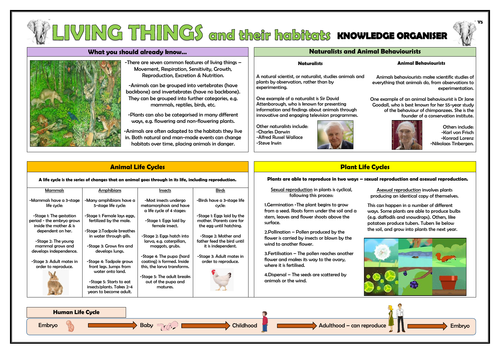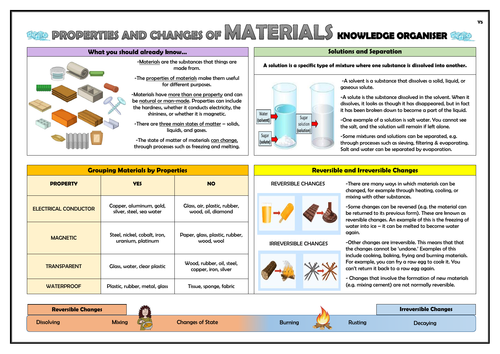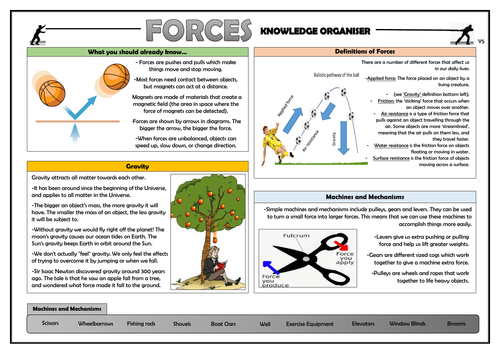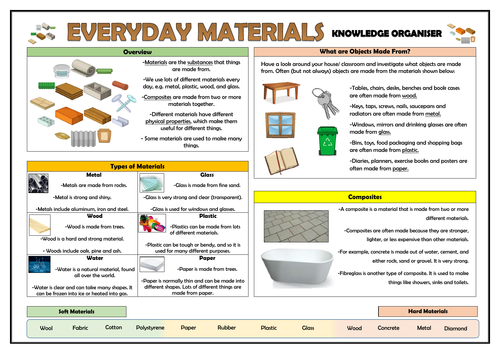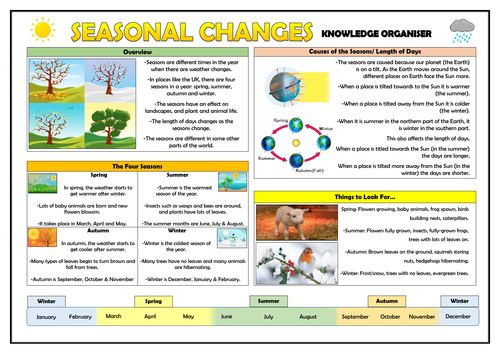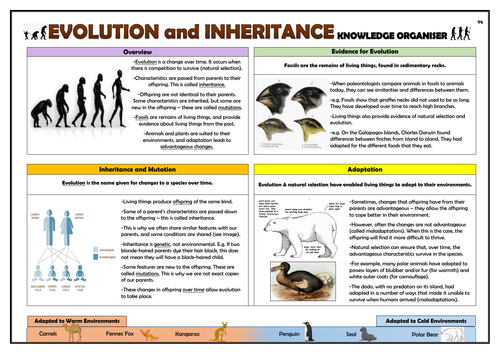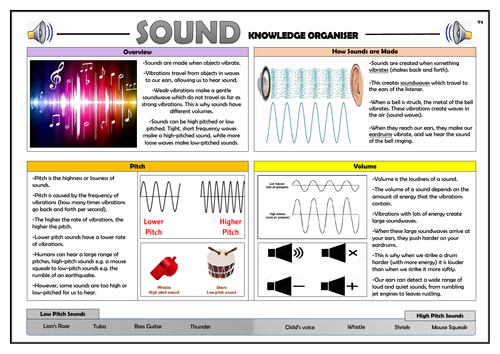
3k+Uploads
1896k+Views
2230k+Downloads
Primary science

Year 6 Light Knowledge Organiser!
This clear, detailed and visually-appealing resource offers a complete reference point for Year 6 children, teachers and parents covering knowledge relating to ‘Light’, as a part of their science learning. It contains comprehensive sections on:
Overview;
How We See Things;
How Light Travels;
Our Eyes;
Light Spectrum;
Key Vocabulary (underlined).
The content is fully aligned with the NC expectations for Year 6 children relating to ‘Light:’
-Recognise that light appears to travel in straight lines;
-Use the idea that light travels in straight lines to explain that objects are seen
because they give out or reflect light into the eye;
-Explain that we see things because light travels from light sources to our eyes or
from light sources to objects and then to our eyes;
-Use the idea that light travels in straight lines to explain why shadows have the same shape as the objects that cast them.
The resource is designed to be printed onto A3, and is provided as both a PDF and a Word version (so that you can edit if you want to). All images used are licensed for commercial use and are cited on a separate document (included).

Year 4 Living Things and their Habitats - Knowledge Retrieval Activities Pack!
This resource offers a wide range of knowledge retrieval activities for those studying Living Things and their Habitats in Year 4.
It covers information including classification of animals, features of living things, classification of plants, key vocabulary and habitat changes.
There are a wide range of interesting and thought-provoking activities (over 30 slides in total) which help children to secure all of the important information from the unit. Research-approved activities include:
-Quick Fire Questions;
-Picture Stimulus;
-Retrieval Grid;
-Fill in the Blank;
-Vocabulary Busters;
-Fact Dump;
-Rank 5;
-Detective/ Questioning Tasks;
-Anagrams;
These resources are tried and tested in the classroom and have proven successful in helping children to consolidate key information within this unit.

Crazy Animal Limericks Anthology! (Original Poems and Comprehension Tasks!)
This limerick anthology and comprehension pack contains over 20 pages of original, child-friendly, and humorous limerick poems, alongside differentiated comprehension resources for beginner, intermediate, and expert limerick learners.
I made these resources when I was writing a limerick scheme of learning a while back - I was disappointed with the lack of age-appropriate limericks available (that were suitable for KS1 and KS2 children, and still met the structural requirements of the poetic form). Therefore I began designing this anthology - from fashion-loving crocodiles, to sun-bathing penguins, to crime-fighting fish, to geese with anger management issues, all of the limericks here have gone down really well with all of the children that I have taught.
The comprehension tasks enable students to meet a number of the key expectations for Reading within the new National Curriculum. They focus upon comprehension of key elements such as interpretation of subject matter, analysis of language, and comments upon structural organisation.
The anthology contains a number of images, all of which are licensed for commercial use. Citations of these can be found on the final page of the anthology.
Many Thanks!

Year 5 Living Things and their Habitats Knowledge Organiser!
This clear, detailed and visually-appealing resource offers a complete reference point for Year 5 children, teachers and parents covering knowledge relating to ‘Living things and their habitats’, as a part of their science learning. It contains comprehensive sections on:
What you should already know (from learning in earlier years);
Animal Life Cycles;
Plant Life Cycles;
Habitat Changes;
Naturalists and Animal Behaviourists;
Key Vocabulary.
The content is fully aligned with the NC expectations for Year 5 children relating to ‘Living things and their habitats’:
-Describe the differences in the life cycles of a mammal, an amphibian, an insect and a bird;
-Describe the life process of reproduction in some plants and animals.
The resource is designed to be printed onto A3, and is provided as both a PDF and a Word version (so that you can edit if you want to). All images used are licensed for commercial use and are cited on a separate document (included).

Tree: Seasons Come, Seasons Go - Whole Class Reading Session!
This whole class reading session aims to develop children’s fluency and comprehension skills through reading Britta Teekuntrup’s ‘Tree: Seasons Come, Seasons Go.’
The reading is followed by a series of activities aiming to develop children’s retrieval, explanation, inference, prediction and summarising skills. It also contains a vocabulary check immediately after the extract is read to clarify any unfamiliar/ difficult language.
The tasks are comprised of quick-check questions, solo thinking, pair/ group discussions and deeper thinking activities. The text is hyperlinked (first slide) for ease of access.
The session is best suited for children in years 1-2, although with minor adaptations it could feasibly be used with slightly younger and older year groups.

Year 5 Properties and Changes of Materials Knowledge Organiser!
This clear, detailed and visually-appealing resource offers a complete reference point for Year 5 children, teachers and parents covering knowledge relating to ‘Properties and Changes of Materials’, as a part of their science learning. It contains comprehensive sections on:
What you should already know (from learning in earlier years);
Grouping Materials by Properties;
Solutions and Separation;
Reversible and Irreversible Changes;
Types of Reversible and Irreversible Changes;
Key Vocabulary.
The content is fully aligned with the NC expectations for Year 5 children relating to ‘Properties and Changes of Materials’:
-Compare and group together everyday materials on the basis of their properties,
including their hardness, solubility, transparency, conductivity (electrical and
thermal), and response to magnets;
-Know that some materials will dissolve in liquid to form a solution, and describe how to recover a substance from a solution;
-Use knowledge of solids, liquids and gases to decide how mixtures might be
separated, including through filtering, sieving and evaporating;
-Give reasons, based on evidence from comparative and fair tests, for the particular
uses of everyday materials, including metals, wood and plastic;
-Demonstrate that dissolving, mixing and changes of state are reversible changes;
-Explain that some changes result in the formation of new materials, and that this kind of change is not usually reversible, including changes associated with burning and the action of acid on bicarbonate of soda.
The resource is designed to be printed onto A3, and is provided as both a PDF and a Word version (so that you can edit if you want to). All images used are licensed for commercial use and are cited on a separate document (included).

Year 2 Use of Everyday Materials Knowledge Organiser!
This clear, detailed and visually-appealing resource offers a complete reference point for Year 2 children, teachers and parents covering knowledge relating to ‘Use of Everyday Materials’, as a part of their science learning. It contains comprehensive sections on:
Overview;
Types of Materials;
Properties of Materials;
Development of Materials;
Key Vocabulary
The content is fully aligned with the NC expectations for Year 2 children relating to ‘Use of Everyday Materials:’
identify and compare the suitability of a variety of everyday materials, including
wood, metal, plastic, glass, brick, rock, paper and cardboard for particular uses
find out how the shapes of solid objects made from some materials can be changed by squashing, bending, twisting and stretching.
The resource is designed to be printed onto A3, and is provided as both a PDF and a Word version (so that you can edit if you want to). All images used are licensed for commercial use and are cited on a separate document (included).

Year 5 Forces Knowledge Organisers!
This clear, detailed and visually-appealing resource offers a complete reference point for Year 5 children, teachers and parents covering knowledge relating to ‘Forces’, as a part of their science learning. It contains comprehensive sections on:
What you should already know (from prior learning);
Gravity;
Definition of Forces;
Machines and Mechanisms;
Types of Machines and Mechanisms;
Key Vocabulary.
The content is fully aligned with the NC expectations for Year 5 children relating to ‘Forces’:
-explain that unsupported objects fall towards the Earth because of the force of
gravity acting between the Earth and the falling object;
-identify the effects of air resistance, water resistance and friction, that act between moving surfaces;
-recognise that some mechanisms, including levers, pulleys and gears, allow a
smaller force to have a greater effect.
The resource is designed to be printed onto A3, and is provided as both a PDF and a Word version (so that you can edit if you want to). All images used are licensed for commercial use and are cited on a separate document (included).

Year 4 Animals Including Humans Knowledge Organiser!
This clear, detailed and visually-appealing resource offers a complete reference point for Year 4 children, teachers and parents covering knowledge relating to ‘Animals including Humans’, as a part of their science learning. It contains comprehensive sections on:
Overview and ‘what you should already know’ (from their prior learning);
Food Chains Explanation and Key Terms;
Example Food Chains;
Teeth;
The Digestive System;
Key Vocabulary (underlined).
The content is fully aligned with the NC expectations for Year 4 children relating to ‘Animals including Humans:’
-describe the simple functions of the basic parts of the digestive system in humans
-identify the different types of teeth in humans and their simple functions
-construct and interpret a variety of food chains, identifying producers, predators and prey.
The resource is designed to be printed onto A3, and is provided as both a PDF and a Word version (so that you can edit if you want to). All images used are licensed for commercial use and are cited on a separate document (included).

All About Newts - KS2 Non-Fiction Reading Comprehension!
This whole class reading session aims to develop children’s fluency and comprehension skills through reading an information factfile about newts (the text is two A4 sides in length).
The reading is followed by a series of activities aiming to develop children’s VIPERS skills: vocabulary, inference, prediction, explanation, retrieval, sequencing and summarising. It also contains a vocabulary check immediately after the extract is read to clarify any unfamiliar/ difficult language.
The tasks are comprised of quick-check questions, solo thinking, pair/ group discussions and deeper thinking activities. The extract needed is provided in both PDF and Word format.
The session is best suited for children across KS2, I have previously used the resources with years 3, 4, and 5.

Alexander Graham Bell - Knowledge Organiser!
This clear, detailed and visually-appealing resource offers a complete reference point for children learning about Alexander Graham Bell, particularly those studying ‘Significant Individuals’ in history or about prominent inventors in science. It contains comprehensive sections entitled:
Overview;
Times in His Life;
Important Vocabulary;
Alexander Graham BellTimeline;
Answers to the Important Questions;
Top Ten Facts.
The resource is designed to be printed onto A3, and is provided as both a PDF and a Word version (so that you can edit if you want to). All images used are licensed for commercial use.

Year 1 Everyday Materials Knowledge Organiser!
This clear, detailed and visually-appealing resource offers a complete reference point for Year 1 children, teachers and parents covering knowledge relating to ‘Everyday Materials’, as a part of their science learning. It contains comprehensive sections on:
Overview;
Types of Materials;
What are Objects Made from?
Composites;
Soft/Hard Materials Continuum;
Key Vocabulary (underlined).
The content is fully aligned with the NC expectations for Year 1 children relating to ‘Everyday Materials:’
-distinguish between an object and the material from which it is made
-identify and name a variety of everyday materials, including wood, plastic, glass,
metal, water, and rock
-describe the simple physical properties of a variety of everyday materials
-compare and group together a variety of everyday materials on the basis of their
simple physical properties.
The resource is designed to be printed onto A3, and is provided as both a PDF and a Word version (so that you can edit if you want to). All images used are licensed for commercial use and are cited on a separate document (included).

Year 1 Seasonal Changes Knowledge Organiser!
This clear, detailed and visually-appealing resource offers a complete reference point for Year 1 children, teachers and parents covering knowledge relating to ‘Seasonal Changes’, as a part of their science learning. It contains comprehensive sections on:
Overview;
The Four Seasons;
Seasons Over the Calendar Year;
Cause of the Seasons/ Length of Days;
Things to Look For;
Key Vocabulary.
The content is fully aligned with the NC expectations for Year 1 children relating to ‘Seasonal Changes:’
-observe changes across the four seasons
-observe and describe weather associated with the seasons and how day length
varies
The resource is designed to be printed onto A3, and is provided as both a PDF and a Word version (so that you can edit if you want to). All images used are licensed for commercial use and are cited on a separate document (included).

Year 6 Evolution and Inheritance Knowledge Organiser!
This clear, detailed and visually-appealing resource offers a complete reference point for Year 6 children, teachers and parents covering knowledge relating to ‘Evolution and Inheritance’, as a part of their science learning. It contains comprehensive sections on:
Overview;
Inheritance and Mutation;
Evidence of Evolution;
Adaptation;
Animal Adaptations;
Key Vocabulary (underlined).
The content is fully aligned with the NC expectations for Year 6 children relating to ‘Evolution and Inheritance:’
-Recognise that living things have changed over time and that fossils provide
information about living things that inhabited the Earth millions of years ago;
-Recognise that living things produce offspring of the same kind, but normally offspring vary and are not identical to their parents;
-Identify how animals and plants are adapted to suit their environment in different
ways and that adaptation may lead to evolution.
The resource is designed to be printed onto A3, and is provided as both a PDF and a Word version (so that you can edit if you want to). All images used are licensed for commercial use and are cited on a separate document (included).

Year 2 Animals Including Humans Knowledge Organiser!
This clear, detailed and visually-appealing resource offers a complete reference point for Year 2 children, teachers and parents covering knowledge relating to ‘Animals including Humans’, as a part of their science learning. It contains comprehensive sections on:
Overview and ‘what you should already know’ (from their prior learning);
Basic Needs of Animals;
Life Stages of Animals;
Reproduction and Growth;
Staying Healthy;
Key Vocabulary (underlined).
The content is fully aligned with the NC expectations for Year 2 children relating to ‘Animals including Humans:’
-notice that animals, including humans, have offspring which grow into adults
-find out about and describe the basic needs of animals, including humans, for
survival (water, food and air)
-describe the importance for humans of exercise, eating the right amounts of different
types of food, and hygiene.
The resource is designed to be printed onto A3, and is provided as both a PDF and a Word version (so that you can edit if you want to). All images used are licensed for commercial use and are cited on a separate document (included).

Year 4 Sound Knowledge Organiser!
This clear, detailed and visually-appealing resource offers a complete reference point for Year 4 children, teachers and parents covering knowledge relating to ‘Sound’, as a part of their science learning. It contains comprehensive sections on:
Overview;
How Sounds are Made;
Pitch;
Volume;
High and Low Pitch Sounds Continuum;
Key Vocabulary.
The content is fully aligned with the NC expectations for Year 4 children relating to ‘Sounds’:
-Identify how sounds are made, associating some of them with something vibrating;
-Recognise that vibrations from sounds travel through a medium to the ear;
-Find patterns between the pitch of a sound and features of the object that produced it;
-Find patterns between the volume of a sound and the strength of the vibrations that produced it;
-Recognise that sounds get fainter as the distance from the sound source increases.
The resource is designed to be printed onto A3, and is provided as both a PDF and a Word version (so that you can edit if you want to). All images used are licensed for commercial use and are cited on a separate document (included).

Year 6 Living Things and their Habitats Knowledge Organiser!
This clear, detailed and visually-appealing resource offers a complete reference point for Year 6 children, teachers and parents covering knowledge relating to ‘Living things and their habitats’, as a part of their science learning. It contains comprehensive sections on:
What you should already know (from learning in earlier years);
In-depth Classification of Animals;
Linnaeus Classification;
Classification in Habitats;
Classification of Humans;
Key Vocabulary.
The content is fully aligned with the NC expectations for Year 6 children relating to ‘Living things and their habitats’:
-Describe how living things are classified into broad groups according to common
observable characteristics and based on similarities and differences, including microorganisms, plants and animals;
-Give reasons for classifying plants and animals based on specific characteristics.
The resource is designed to be printed onto A3, and is provided as both a PDF and a Word version (so that you can edit if you want to). All images used are licensed for commercial use and are cited on a separate document (included).
Bundle Sale

KS2 Design and Technology Knowledge Organisers Bundle!
These clear, detailed and visually-appealing resources offer a complete reference point for children, teachers and parents building knowledge of the KS2 Design and Technology curriculum. The organisers are clear, logical and fully aligned with the expectations of the National Curriculum.
Included are organisers based on:
-Structures: Shell Structures;
-Structures: Frame Structures;
-Mechanisms: Gears and Pulleys;
-Textiles: Simple Sewing;
-Textiles: More Complex Sewing;
-Electrical Systems: Simple Circuits and Switches;
-Electrical Systems: More Complex Circuits and Switches;
-Food and Nutrition: Healthy and Varied Diet;
-Food and Nutrition: Culture and Seasonality
The resources are designed to be printed onto A3 (although can be printed onto A4), and are provided in both PDF and Word versions (so that you can edit if you want to). All images used are licensed for commercial use and are cited on a separate document (included).

Planet Earth Knowledge Organiser!
This clear, detailed and visually-appealing resource offers a complete reference point for subject leaders, teachers and students building knowledge relating to the planet Earth. It contains comprehensive sections on:
Earth Overview;
Physical Characteristics;
Key Facts;
Comparison with Other Planets;
Important Vocabulary;
Position in the Solar System.
The resource is designed to be printed onto A4 or A3, and is provided as both a PDF and a Word version (so that you can edit if you want to). All images used are licensed for commercial use and are cited on a separate document (included).

Year 2 Plants Knowledge Organiser!
This clear, detailed and visually-appealing resource offers a complete reference point for Year 2 children, teachers and parents covering knowledge relating to ‘Plants’, as a part of their science learning. It contains comprehensive sections on:
What you should already know (from earlier learning);
What Plants Need to Grow;
Growth from Seeds/Bulbs into Mature Plants;
Plant Life Cycle;
Shorter and Taller Plants Continuum;
Key Vocabulary.
The content is fully aligned with the NC expectations for Year 2 children relating to ‘Plants’:
-observe and describe how seeds and bulbs grow into mature plants;
-find out and describe how plants need water, light and a suitable temperature to grow and stay healthy.
The resource is designed to be printed onto A3, and is provided as both a PDF and a Word version (so that you can edit if you want to). All images used are licensed for commercial use and are cited on a separate document (included).




